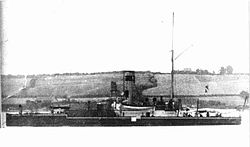Bee (ship)
|
The type ship wasp
|
||||||||||||||||||||||
|
||||||||||||||||||||||
|
||||||||||||||||||||||
|
||||||||||||||||||||||
|
||||||||||||||||||||||
The Biene was the third ship in the Wespe class , a class of eleven armored cannon boats of the Imperial Navy , which was designed for the defense of the German North and Baltic Sea coasts.
Construction and service time
The ship with the household name Panzerfahrzeug C was built by Bremer Werft AG Weser , like all units of the Wespe class . Work began in 1875. The ship received armor from British production, as Dillinger Hütte , which was actually commissioned with the delivery of the armor plates, was not yet able to produce them in the required quality. The new building was ready for launch on December 2, 1876 and was named after the insect group of bees .
After the ship was completed on October 17, 1877, it took almost four years before the bee was first put into service for training purposes on August 20, 1881. Three weeks later the order was given to go to Kiel . Since the Kaiser Wilhelm Canal did not exist at that time, the march around Skagen had to be started, which lasted three days. The bee reached Kiel on September 11th. On 17 September, she was again placed out of service after the previous day of events the Navy during a visit Kaiser Wilhelm I had participated.
It was not put into service again until April 22, 1884. The bee was combined with its sister ships Camaeleon , Crocodill and Hummel to form the Panzerkanonenboots-Division under the command of Captain Karl August Deinhard . The association started on May 8th of the same year with exercises in the waters of Rügen . For the bee these exercises ended on June 8 due to the Rügischer Bodden suffered damage . She had to visit the Kaiserliche Werft Kiel and was decommissioned there on June 12, 1884. Their place in the Division took the snake one.
Whereabouts
Although it was still assigned to the naval station of the Baltic Sea , the bee was not activated again, but remained in the reserve until it was removed from the list of warships on September 27, 1910. Her hull served as a floating workshop until 1921, when it was sold to Bremen for 660,000 marks and scrapped in Wewelsfleth .
Commanders
| August 20 to September 17, 1881 | Lieutenant Captain von Raven |
| April 22nd to June 12th, 1884 | Lieutenant Wilm |
literature
- Gröner, Erich / Dieter Jung / Martin Maass: The German warships 1815-1945 . tape 1 : Armored ships, ships of the line, battleships, aircraft carriers, cruisers, gunboats . Bernard & Graefe Verlag, Munich 1982, ISBN 3-7637-4800-8 , p. 164 f .
- Hildebrand, Hans H. / Albert Röhr / Hans-Otto Steinmetz: The German warships . Biographies - a mirror of naval history from 1815 to the present . tape 2 : Ship biographies from Baden to Eber . Mundus Verlag, Ratingen, S. 63 f .
